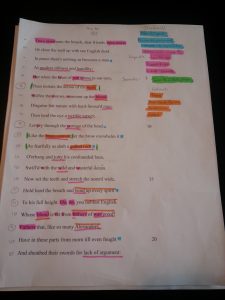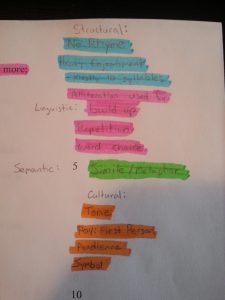When reading a Shakespeare passage it is easy to lose track of the meaning in both the entire passage, and of the individual words on the page. Close reading serves to closely examine both of these elements and annotating the passage is the best tool to keep track of your progress.
Before writing any annotations I found it important to read over the entire passage multiple times to try and build a general impression on what the scene is about. Personally, I find more often than not that I do not understand what the lines or even the words themselves mean, but can pick out certain words and use sentence structure to build an initial interpretation.
My first read through involving annotations focuses on defining individual words or groups of words in a way that makes sense to me. For example, in Henry V Act 3.1.1-34, I initially read through the text and translated fragments of sentences to develop a better understanding of the words chosen.
 I would translate individual words such as “aspect” into a recognizable word like “sight”, or a group of words such as “portage of the head” into “eye sockets”, which makes much more sense to me.
I would translate individual words such as “aspect” into a recognizable word like “sight”, or a group of words such as “portage of the head” into “eye sockets”, which makes much more sense to me.
By first isolating these small fragments and understanding their meaning it is much easier to see how they form building blocks for even more confusing and complicated lines.
The next round of annotation involves translating entire lines into a more modern interpretation that holds personal meaning to me. Admittedly the depth of expression is lost at this point and if someone was to read my version they would be unimpressed, however; the purpose in the end is to have a version of the document that I can quickly reference and understand. I simply rewrite my translation in the margin to the right.


As seen here, “Hold hard the breath and bend up every spirit to his full height. On, On, you noblest English.” has been simplified to “Take a deep breath and conjure all your will. Lets do this guys”. This is far less poetic but essentially means the same thing.
 After obtaining a literal understanding of the words on the page I will take a second copy of the passage and do separate annotations that focus on the structural, linguistic, semantic, and cultural importance of the passage. While doing this it is very useful to color coordinate points of interest.
After obtaining a literal understanding of the words on the page I will take a second copy of the passage and do separate annotations that focus on the structural, linguistic, semantic, and cultural importance of the passage. While doing this it is very useful to color coordinate points of interest.
In the same way that my first copy of annotations is a quick reference to the meaning or words phrases and lines, this copy is a quick reference to why those words may have been chosen in the first place and how they play off each other.

My legend in the top right margin outlines the elements I am looking for and color coordinates them for easy reference. Large categories are further broken down into individual elements. The structural category encompasses the rhyme scheme (if any), the use of enjambment, and the syllable count of each line. The linguistic category covers alliterations, repetition of key words and sounds. The semantic section looks for the use of similes and metaphors, and the cultural category notes the use of symbols and references that provide tone and meaning to the work as it was presented in it’s time.
 This particular screen shot (Left) shows example of the alliteration found in “Stiffen the sinews, summon…” The green bars indicate that a simile or metaphor is being used, and the words highlighted in orange are being used as symbols that describe how Henry’s soldiers should appear to their enemy. To compare someone to a brass cannon then has the same impact as comparing someone to a tank today.
This particular screen shot (Left) shows example of the alliteration found in “Stiffen the sinews, summon…” The green bars indicate that a simile or metaphor is being used, and the words highlighted in orange are being used as symbols that describe how Henry’s soldiers should appear to their enemy. To compare someone to a brass cannon then has the same impact as comparing someone to a tank today.
When writing annotations for a film I find I pay very little attention to the words themselves and put far more attention to cinematic elements such as music, camera angles, scenery, acting and frame.
To use Branagh’s Eve of Saint Crispin’s Day speech as example, my notes cover how the camera always looks up at Henry, and throughout the shot the crowd and camera will follow him as he walks through the scene. As his speech starts to escalate he literally climbs a wagon to walk above his people. Some of the most intense moments are when he is yelling and the camera is close enough to see the spit fly from his mouth.
The music is energetic and triumphant while Henry is speaking and only breaks to a more menacing tone when the french messenger makes his appearance. The tone and power of the music closely mirrors that of Henry’s voice. During the quite parts of his speech the music cuts low but then builds back at the same rate as Henry.
Since film is primarily a visual medium, the props, scenery and wardrobe are heavily noted. As in this scene Henry is brightly dressed while everyone around him wears brown, signifying his importance.
When comparing my notes between film and text, I focus on very different elements but with the same purpose; to better understand and appreciate the intended message.
Leave a Reply
You must be logged in to post a comment.